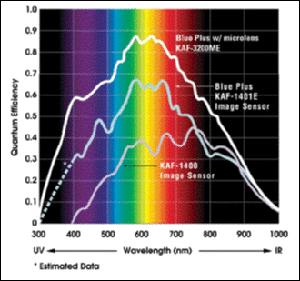Paula M. Powell, Senior Editor
Although the line between the functionality of CMOS and CCD imaging sensors has blurred for many applications, there are still times when one is a more optimum solution. Consider, for example, higher-performance scientific, astronomical and medical applications that demand extremely low noise and dark current, as well as high sensitivity. Here, the selection process will probably lean more toward CCD sensors, said Helen Titus, marketing manager at Eastman Kodak Co.'s Imaging Sensors Div. in Rochester, N.Y. By combining transparent gate technology that it introduced in 1999 with microlens technology that is usually employed on interline CCDs, the firm can reach 85 percent peak quantum efficiency with a full-frame CCD imager that also offers 3-pA/cm2 typical dark current at 25 °C and 55-ke full well in a 6.8-µm pixel.

Although peak quantum efficiency reaches 85 percent for full-frame, front-illuminated CCD imagers that combine an ITO gate material with microlens technology, quantum efficiency exceeding 50 percent at 800 nm also offers the potential to expand near-IR biological applications. The three images at left, courtesy of Roper Scientific, show fluorescently tagged structures.
To maximize sensitivity in a CCD imaging sensor, it is usually necessary to reduce the amount of light absorbed in the gate electrodes lying on top of each pixel. According to Titus, there are two basic ways to do that. One is to thin the sensor substrate and illuminate the pixels from the back side, producing very high quantum efficiency from the UV to the near-IR. This, however, is often at the expense of higher cost per chip because of reduced manufacturing yield. Dark current also increases.
 Kodak chose an alternate approach that replaces one of the polysilicon electrodes used in full-frame sensors with a more transparent indium-tin-oxide (ITO) material. This provides better index-matching with the silicon below, reducing reflection losses and allowing more light to pass through the sensor pixels. Light is redirected from the polysilicon to the ITO electrode using small microlenses formed over each pixel during the production process.
Kodak chose an alternate approach that replaces one of the polysilicon electrodes used in full-frame sensors with a more transparent indium-tin-oxide (ITO) material. This provides better index-matching with the silicon below, reducing reflection losses and allowing more light to pass through the sensor pixels. Light is redirected from the polysilicon to the ITO electrode using small microlenses formed over each pixel during the production process.
This technique is not new. The company introduced a 3.2-megapixel sensor based on it in 2001. At the time, the 85 percent peak quantum efficiency represented an 18 percent gain over that which was possible with the sensor's predecessors. Quantum efficiency improved 49 percent for the blue wavelengths and 25 percent for the near-IR.
What is new is that such gains in peak quantum efficiency have become available in lower-resolution and, hence, lower-cost sensors. Some sensors now pair 85 percent peak quantum efficiency with 0.4-, 1.4- and 1.6-megapixel resolution, and their monochrome sensitivity has reportedly increased 50 percent in the visible and near-IR wavelengths compared with their predecessors.
Titus estimated that the price drops about 40 percent from the 3.2-megapixel sensor to the 1.4-megapixel device. She said she believes that no CMOS sensors on the market can match the noise performance of this family of CCD sensors and also offer the dynamic range -- about 16 bits -- commonly demanded in scientific applications. Potential beneficiaries of the cost drop range from amateur astronomy to scientific applications as diverse as x-ray imaging and DNA sequencing.